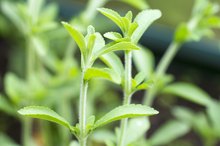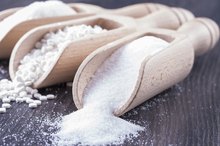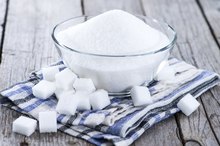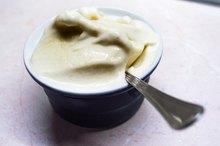Possible Side Effects of Maltodextrin and Sucralose
Sucralose and maltodextrin are two of the main ingredients in the artificial sweetener Splenda. Sucralose was approved by the U.S. Food and Drug Administration for use as a sweetener in 1998 and is considered safe. However, both of these ingredients have the potential to cause side effects in at least some individuals, especially if consumed in large amounts.
Potential Sucralose Adverse Effects
Like some other artificial sweeteners, sucralose can cause gas, bloating and diarrhea and can have laxative effects. Sucralose may also be associated with increased symptoms of inflammatory bowel disease, reports the Center for Science in the Public Interest, although the research in this area is still preliminary. Limiting the amount of sucralose you consume can help prevent these potential side effects. The U.S. Food and Drug Administration recommends consuming no more than 2.3 milligrams of sucralose per pound of body weight per day, or about 341 milligrams for a 150-pound person. To put this into perspective, a diet soda sweetened with sucralose typically contains between 40 and 60 milligrams of sucralose.
- Like some other artificial sweeteners, sucralose can cause gas, bloating and diarrhea and can have laxative effects.
- To put this into perspective, a diet soda sweetened with sucralose typically contains between 40 and 60 milligrams of sucralose.
Potential Maltodextrin Side Effects
Stevia Vs. Saccharin
Learn More
Maltodextrin is often combined with sucralose to give it more bulk, making it possible for people to use it in a 1-1 ratio when substituting for sugar. The maltodextrin used in Splenda is made from cornstarch, but this texturizer can also be made from rice, potato or wheat. In the case of wheat, it will be noted on the label, as this could cause symptoms of an allergic reaction, including rash, swelling and difficulty breathing. Maltodextrin made from wheat could also cause side effects in people with celiac disease or gluten sensitivity. These include diarrhea, bloating, rash and muscle cramps.
- Maltodextrin is often combined with sucralose to give it more bulk, making it possible for people to use it in a 1-1 ratio when substituting for sugar.
- The maltodextrin used in Splenda is made from cornstarch, but this texturizer can also be made from rice, potato or wheat.
Sucralose Plus Maltodextrin and Weight
Artificial sweeteners are sometimes used in an attempt to cut calories and lose weight. However, some research indicates that these sweeteners may have the opposite effect, according to an article published in the Yale Journal of Biology and Medicine in June 2010. This could be due to people overcompensating for the calories they save by eating more or the sweet taste causing cravings for more sweet foods, thus producing an increase in calorie consumption.
Other Potential Considerations
Canderel Side Effects
Learn More
A study published in the Journal of Toxicology and Environmental Health -- Part A in 2008 found that consuming Splenda caused decreases in beneficial bacteria and caused other changes in the guts of rats that could limit the effectiveness of certain medications. Further research is necessary to determine whether it has this effect in people as well. Sucralose may also increase blood sugar levels to some extent. A study published in Diabetes Care in April 2013 found that people experienced increases in blood sugar after drinking a beverage sweetened with sucralose but didn't experience these increases when drinking water, which was the control beverage.
- A study published in the Journal of Toxicology and Environmental Health -- Part A in 2008 found that consuming Splenda caused decreases in beneficial bacteria and caused other changes in the guts of rats that could limit the effectiveness of certain medications.
Related Articles
References
- Center for Science in the Public Interest: Chemical Cuisine
- NYU Langone Medical Center: The Skinny on Sucralose
- Journal of Toxicology and Environmental Health -- Part A: Splenda Slters Gut Microflora and Increases Intestinal P-Glycoprotein and Cytochrome P-450 in Male Rats
- Yale Journal of Biology and Medicine: Gain Weight by “Going Diet?” Artificial Sweeteners and the Neurobiology of Sugar Cravings
- Splenda: Splenda FAQs
- Cleveland Clinic: Celiac Disease
- Diabetes Care: Sucralose Affects Glycemic and Hormonal Responses to an Oral Glucose Load
- Aldeeb OA, Mahgoub H, Foda NH. Sucralose. Profiles Drug Subst Excip Relat Methodol. 2013;38:423-62. doi:10.1016/B978-0-12-407691-4.00010-1
- Sucralose. About sucralose.
- Fitch C, Keim KS; Academy of Nutrition and Dietetics. Position of the Academy of Nutrition and Dietetics: use of nutritive and nonnutritive sweeteners. J Acad Nutr Diet. 2012;May;112(5):739-58. doi: 10.1016/j.jand.2012.03.009
- Fitch C, Keim KS; Academy of Nutrition and Dietetics. Position of the Academy of Nutrition and Dietetics: use of nutritive and nonnutritive sweeteners. J Acad Nutr Diet. 2012;May;112(5):739-58. doi: 10.1016/j.jand.2012.03.009
- Grotz VL1, Munro IC. "An overview of the safety of sucralose." Regul Toxicol Pharmacol. 2009 Oct;55(1):1-5.
Writer Bio
Based in Massachusetts, Jessica Bruso has been writing since 2008. She holds a master of science degree in food policy and applied nutrition and a bachelor of arts degree in international relations, both from Tufts University.









